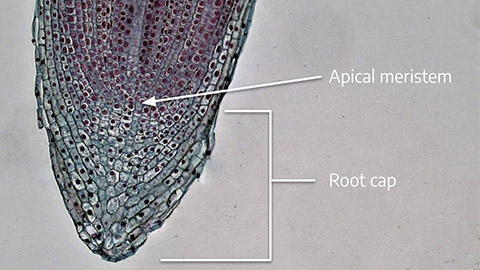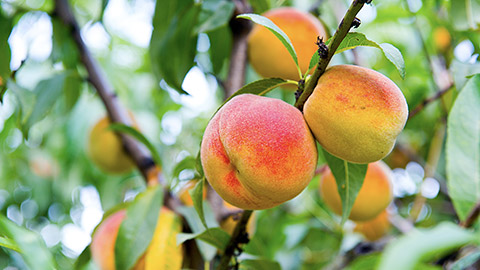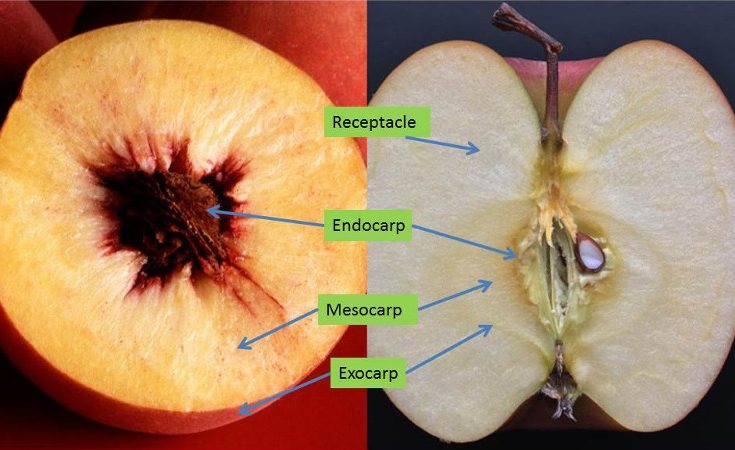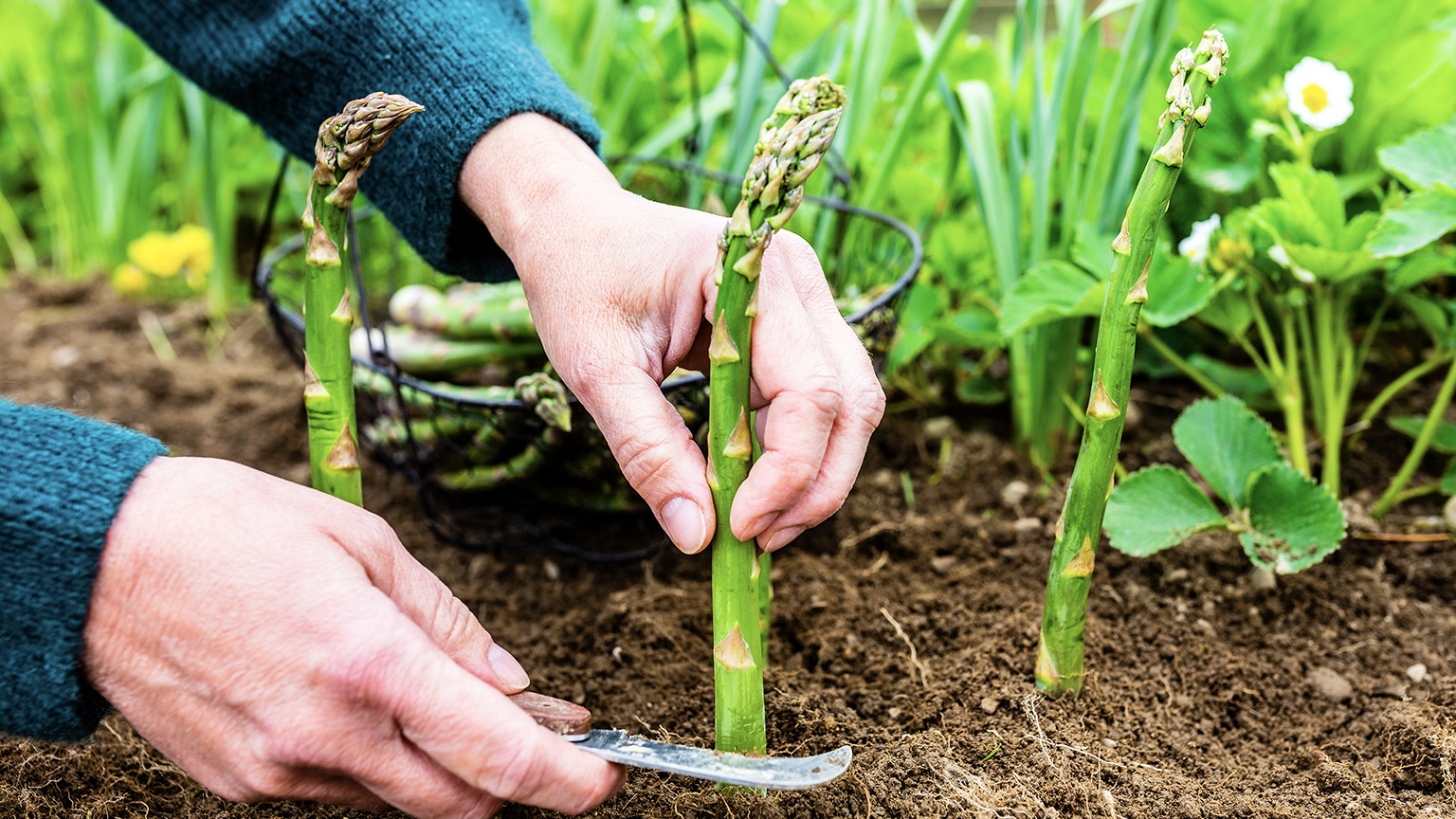The part of the Asparagus plant (Asparagus officinalis) we eat is the stem.
We’ll learn about the various parts that make up plants in this topic. Beyond stems, leaves, flowers, and roots, we’ll look at the smaller, lesser-known, but no less important structures.
Like humans and all other living things, plants are made up of tiny cells.
These cells are just about 0.05mm wide and act like tiny factories producing everything the plant needs, using only air, water, and nutrients from the soil. These factories can copy themselves and multiply, which leads to growth (getting bigger) and development (creation of new structures) of the plant.
Why you need to know
This topic is important because it introduces key scientific terms you’ll need to know to make sense of the following topic on plant processes.
Additionally, if you plan on getting a job in the horticulture industry, knowing what these words mean will help you discuss plants with others.
In this topic, we look at the main plant structures (plant parts), including:
- meristems
- roots
- stems
- nodes
- buds
- leaves
- flowers
- fruit.
Meristems
Meristems are the areas of a plant where cells actively multiply by dividing into two identical cells, a process called mitosis. Meristems aren’t visible to the naked eye but can be seen under a microscope.
There are two main types of meristems:
- Apical meristems: These are located at the tip (or apex) of roots and shoots and are responsible for primary growth, which is the elongation of the plant. They give rise to the primary tissues of the plant.

- Lateral meristems: These are responsible for secondary growth, which is an increase in the girth of the plant.
Roots
As Brian Capon puts it, roots
do three things, and do them well: They anchor the plant in the soil; absorb water and minerals; and store excess food for future needs, underground where animals are least likely to find it.Brian Capon, Botany for Gardeners: Revised Edition.
Plants can have different types of roots depending on their species and environment.
However, the two main types of roots are:
- Taproots:

Taproots are large and long primary roots that grow straight into the soil, with smaller lateral roots branching off them. Many dicotyledonous plants have taproots, such as carrots, turnips, and beets. Taproots are good at reaching deep water sources and can provide stability to the plant. - Fibrous roots

Other types of roots include adventitious roots, which arise from stems or leaves rather than from the primary root (i.e. strawberries), and aerial roots, which grow above the ground and absorb moisture from the air (for example, pohutakawa).
Stems
We use the term stem to refer to the main structural parts of the plant that form above ground, specifically:
- A trunk is the stem of a tree that extends from the ground up to the branches.
- Branches are the woody structures that grow out of the trunk or main stem of a tree. They support leaves, flowers, and fruits.
- Rhizomes are underground stems that grow horizontally and produce roots and shoots. Some plants, such as ginger and turmeric, have rhizomes that are used for food or medicinal purposes.
- Stolons are horizontal stems that grows along the ground surface and produce roots and shoots at nodes. Some plants, such as strawberries and mint, have stolons that allow them to spread and form new plants.
Nodes
Nodes are specifics point on plant stems where leaves, buds, branches or other structures are attached, they include:
- Vegetative nodes: These are nodes on a plant stem where leaves and buds are attached and responsible for producing new vegetative growth.
- Reproductive nodes are nodes where flowers or other reproductive structures are attached. They are responsible for producing new flowers, fruits, or seeds.
- Storage nodes: Some plants have nodes that store nutrients, such as carbohydrates or proteins. These storage nodes can be essential energy sources for the plant during periods of stress or limited growth.
- Propagation nodes: Some plants have nodes that are capable of producing new plants through a process called vegetative propagation. These nodes may develop adventitious roots or shoots that can be used to propagate new plants.
- Latent nodes on a plant stem do not produce new growth under normal conditions. Latent nodes may become active in response to certain stimuli, such as pruning. They can be important sources of new growth for the plant.
Nodes are visible as a slight swelling on the stem (see image below).
The term internode is used to describe the part of the stem between nodes and the internode length is the distance between any two nodes.
Buds
Buds are small, undeveloped shoots located at a plant's nodes. They are important because they contain particular tissue that can develop into new stems, leaves, flowers, or other structures.
The main types are:
- Apical buds (or terminal buds) are located at the tip or apex of a plant stem or branch. They are responsible for the primary growth of the stem. They are involved in developing new leaves, flowers, and other structures.
- Lateral buds are located on the sides of a plant stem or branch. They are involved in developing new side shoots and branches, and they can contribute to the overall shape and architecture of the plant.
- Axillary buds are located in the axils of leaves (where the leaf joins the stem). Like lateral buds, they are involved in developing new lateral shoots. They can contribute to the overall branching structure of the plant.
- Flower buds are buds that develop into flowers or inflorescences. They are responsible for the reproductive growth of the plant.
Two branches show the position of several buds and nodes and the internode length between two nodes.
Leaves

Plant leaves are the prominent locations where photosynthesis takes place in most plants. They are typically flat, thin, and broad and attach to the stem or branches of a plant by a petiole or stalk.
Leaves are made up of several layers of cells, including an outer layer called the epidermis, which contains tiny pores called stomata that regulate gas exchange, allowing carbon dioxide to enter the leaf for photosynthesis and oxygen to exit. Beneath the epidermis are several layers of cells containing chloroplasts, responsible for capturing sunlight and converting it into energy through photosynthesis.
The shape, size, and arrangement of leaves can vary greatly depending on the plant species, environmental factors, and the plant's stage of development. Some plants have simple leaves, while others have compound leaves, which are made up of multiple leaflets attached to a single petiole. Leaves can also be classified based on their arrangement on the stem, with some plants having opposite leaves. In contrast, others have alternate or whorled leaves.
The edge of the leaf is called the margin. There are many different types of leaf margins, the most common being:
- Entire: The margin of the leaf is smooth and unbroken.
- Dentate (or toothed): The margin has small, sharp teeth that point outward.
- Serrated (or serrate): The margin has small, pointed teeth that point forward.
- Lobed: The margin has deep, rounded or pointed indentations.
The descriptions shown here focus only on the leaf edges. There are other descriptions for the tip, base, and shape of the leaf, which you may research on your own if you are interested to expand your learning.
Flowers
Angiosperms produce flowers that, if pollinated and fertilised (sexual fertilisation, not the application of fertiliser products) will form fruit.
Flower parts
- The pistil is a flower's female reproductive organ, typically located at the centre of the flower. It is made up of the stigma, style, and ovary:
- The stigma is the sticky, often knob-like structure at the top of the pistil, designed to receive pollen from visiting insects or other pollinators.
- The style is the long, slender tube that connects the stigma to the ovary.
- The ovary contains the female gametes (egg cells, inside the ovules) that will be fertilized by the pollen.
- Where it is a single set of stigma, style, and ovary, it can also be called a carpel. The term pistil is used to refer to one or more carpels.
- The stamen is the male reproductive organ of a flower. It is typically composed of two main parts: the anther and the filament.
- The anther is the part of the stamen that produces and contains the pollen. It is usually located at the top of a slender stalk called the filament. The anther is often bilobed (has two lobes) or divided into two compartments, each containing pollen sacs that produce and release pollen grains.
- The filament is the long, slender stalk that supports the anther and positions it above the other parts of the flower to make it easier for pollination to take place. The filament is often flexible and may bend or move in response to changes in temperature or wind.
- Together, the anther and filament make up the stamen, which is responsible for producing and releasing the male gametes (pollen) necessary for fertilisation.
- Petals are modified leaf structures that make up a flower's colourful parts, which attract pollinators like bees, butterflies, and birds to the flower.
- Sepals are modified leaves that form the outermost layer of the flower bud. Sepals are typically green and protect the flower in its early development stage before it becomes a mature flower. Once the flower has fully developed, the sepals may remain attached to the base of the flower or fall off as the petals open.
Differences between wind- and insect-pollinated flowers
Remember, the flowers of wind-pollinated flowers aren’t large and colourful. They don’t need to be flashy because they don’t need to attract animals to pollinate them.
Corn is an example of a plant that is pollinated by wind. It is a monoecious plant (which possesses flowers that have only male sexual parts and flowers that have only female sexual parts on the same plant).
The tassel (the male flower structure at the top of the corn plant) contains the filaments and anthers (which bear pollen). The ear (the female flower structure lower down) contains hundreds of ovaries with one ovule in each. Each ovary is connected to a long silk style with a short stigma at the tip. The female flowers have small, inconspicuous petals, usually yellow or brown.
Dicot and monocot flower types
Dicot flowers
Some of the main types of flowers of dicot plants are:
- Regular flowers: These flowers have symmetrical radial or bilateral symmetry, with all petals and other flower parts identical in shape and size. Examples include roses and buttercups.
- Irregular flowers: These flowers have asymmetrical or irregular shapes, with some petals larger or shaped differently than others. An example of irregular flowers is orchids.
- Composite flowers: These flowers are made up of many small flowers called florets, arranged in a tight cluster (inflorescence – a grouping of small flowers that seems like a larger flower) on a single receptacle. Examples include daisies and sunflowers. The petals are individual flowers called ray flowers, and the middle part is made up of other specialist flowers called disc flowers. The ray flowers are sterile – their reason for existing is to attract the attention of pollinators – while the disc flowers are responsible for producing the seeds used for reproduction.
- Umbels: These flowers have a flat-topped or rounded inflorescence, with all flowers emerging from a single point on the stem. An example is parsley.
- Spikes: These flowers have an elongated, unbranched inflorescence with many small flowers attached directly to the stem. Examples include lupins and sweet peas.
- Racemes: These flowers have a central axis with flowers attached to it by small stalks of equal length, forming an elongated inflorescence. Foxglove is an example of a raceme flower.
Monocot flowers
Some of the main types of monocot flowers are:
- Simple flowers: These are flowers with only one whorl of petals, which are all similar in shape and size. Examples include lilies and orchids.
- Spikelets are clusters of small flowers arranged along a central stem called a spike. Spikelets are characteristic of grasses, such as corn and wheat.
- Catkins are cylindrical or oblong clusters of unisexual flowers that are typically pendulous (hanging). They are found in plants such as willows, birches, and palms.
Differences between dicot and monocot flowers
Both monocot and dicot flowers have the same main parts mentioned above, but there are some differences, including:
- Monocot flowers typically have petals and other floral parts in multiples of three. In contrast, dicot flowers typically have them in multiples of four or five.
- The arrangement of the veins in the petals (and leaves) of monocots and dicots is different. Monocots typically have parallel veins, while dicots have branched or net-like veins.
Fruit

In botany (plant science), the term fruit means the mature ovary of a flowering plant, usually containing seeds. In other words, a fruit is part of the plant that develops from the flower and contains seeds, which are the fertilized and matured ovules.
A note about vegetables: By comparison, there is no scientific meaning for the word vegetable. Many things we call vegetables are, in fact, the fruit of the plant, such as tomatoes, pumpkins and zucchini. Other things we eat are the vegetative parts of the plant, which are not defined as fruit, such as the stalks of celery or rhubarb.
Parts of a fruit
The main parts of a fruit are the pericarp, the seed(s), and sometimes additional structures such as the receptacle.
- Pericarp: The pericarp is the outer layer of the fruit and develops from the ovary wall of the flower. It typically comprises three layers: the outermost layer is called the exocarp, the middle layer is the mesocarp, and the innermost layer is the endocarp. Depending on the type of fruit, these layers may be fleshy or dry.
- Seed(s): The seed(s) are the reproductive part of the fruit and are typically enclosed within the pericarp. Seeds can be single or multiple and are usually surrounded by a protective layer called the testa or seed coat.
- Receptacle: Some fruits may also have additional structures that develop from the base of the flower, such as the receptacle. This tissue supports the ovary and the pericarp and may be fleshy or dry, depending on the type of fruit.

This photo composite from the Toronto Botanical Gardens show the pericarp of a peach (left) and apple (right). Of the peach (and other drupes – stonefruit), the fleshy part we eat is the mesocarp and the skin is the exocarp. Of the apple (and other pomes – pipfruit), the fleshy part we eat is the receptacle, and all parts of the pericarp form the core of the apple.
Categories/Types of fruit
A simple fruit develops from one ovary, with any number of ovules. The peach and apple shown above are examples of simple fruit.
Aggregate fruit develops from the union of multiple ovaries from the same flower, each of which is a small fruit or drupelet that combines and attaches to a central, fleshy receptacle. Examples of aggregate fruit include raspberries, blackberries, and strawberries.
Multiple fruit (also called multi-fruits or collective fruits) forms from the fusion of multiple individual flowers that would have formed a single fruit, but have fused together to form a single item. Pineapples and figs are examples of these types of fruit.
Accessory fruit develops not only from the ovary of a single flower, but also from other parts of the flower that are not directly involved in reproduction, such as the receptacle, floral tube, or other floral organs. The edible part of an accessory fruit is not derived from the ovary, but rather from these other parts.
Common examples of accessory fruits include apples, pears, and quinces — all of which are derived from the flower's receptacle.
